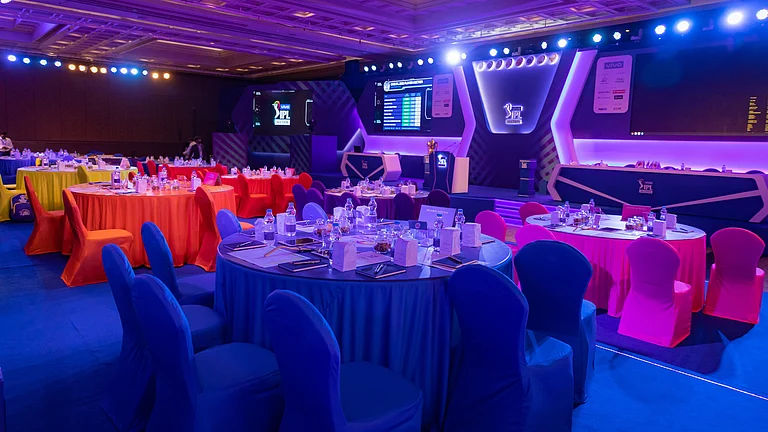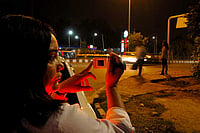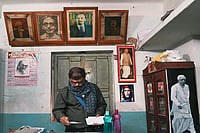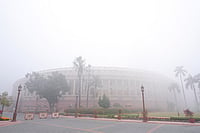Highway wisdom has it that foggy, cold mornings should be countered with a piping hot, lingering breakfast. So here we are, just past 8 am on a fresh Kutchi day, cruising along the plush roads of Gujarat near Bhuj, and the fog gradually clears to the luscious sight of fafda-jalebi. This local breakfast, as many here would confirm, is a favourite for its mix of contrasting flavours. “Pheeka, meetha, teekha—sab ek saath,” explains the spirited Vicky Joshi, who manages his family’s 45-year-old Ashapura Sweets, on the outskirts of Bhuj. He hands over a sheet of newspaper laden with fafda—crisp, deep-fried strips of besan, long and curling at the ends and also just a bit along the length—and fresh jalebis with fried green chillies and a tomato-besan chutney!
Down south from Kutch, in the Saurashtra-Kathiawar region—the lower jaw of Gujarat, as it were—the fafda-jalebi at times morphs into what they call bhavnagri (after Bhavnagar) or ganthiya-jalebi, in which the besan crispies are thick and coarse, the fried green chillies rounder. The ensemble, however, is just as scrumptious.

Local bird? A ‘Kutchi’ chicken masala and fish masala. (Photograph by Apoorva Salkade)
A flavour too many for a morning meal? You’d do well to banish such thoughts while in Gujarat. After all, this is a land where culinary excesses are dismissed quickly, and a robust appetite, with a taste for at least a dozen flavours per meal, is quite the norm. “That’s the secret of my health,” insists the seventysomething Vasantbaa Jadeja, whose son Krutarthsinh and daughter-in-law Yashodhara manage the home-stay we are putting up at in Kutch. The Jadeja home is a sprawling, 100-year-old darbagadh (a small fort) with intricate Kutch-style carvings, delicately restored after both the 1956 and 2001 earthquakes. It lies some 45 km from Bhuj, in a village called Devpur. The foggy morning gives way to a blinding, sunny afternoon, and we willingly escape to the Jadeja kitchen, where vintage vessels are arrayed on shelves that reach the mighty high ceiling and the aroma of simmering ghee fills the air. In keeping with the Rajput tradition in Kutch, where the Jadeja clan ruled once, Vasantbaa cooks us her kitchen favourite, a sweetmeat called maatar. “It’s so called because it’s a mother’s dish for her child—for good health,” she chuckles, mixing wheat flour, jaggery and ghee, all in equal measure, on a low flame, with powdered ginger and gond (acacia gum) thrown in, a winter addition to help battle the cold. When the mixture cools and hardens, it’s cut into pieces and is ready to eat. Maatar’s equivalent in the Saurashtra region is the more popular sukhdi, similar in form, but the proportions in the recipe vary.
In Gujarat, if the terrain changes frequently, as does the dialect—every 12 miles, they say—so does the cuisine. There is no better example of this than in the little town of Bhirandiyara, near the ‘white’ Rann of Kutch, 70-odd km from Bhuj, known just for its mava (khoya). Sold by the gram in little plastic cups at the 15-odd dhabas along the highway, the sweetmeat attracts a huge crowd—tourists, locals, BSF personnel who patrol the salt-flats of the Rann—for a quick snack. Here, sip on a cup of sweet, milky tea—aakha dudh ni cha—but don’t forget this impossibly delectable treat, made from fresh buffalo milk and sugar left to simmer in mammoth pateelas till it turns into thick, brown and gooey khoya. Just perfect for a winter evening.
In Kutch, doubt not, there’s no dearth of nashto (snacks) and mithai, as across the rest of Gujarat. Station Road, near the main inter-city bus-stop in Bhuj, is a foodie’s delight where you’re spoiled for choice between dabeli, a popular street snack, pakwaan, the crispy savoury that’s best had with tea, and an generous array of Kutchi sweets like gulabpak and maisook at the famous Khavda Sweets. We make a beeline for the dabeli—is it Gujarat’s answer to Maharashtra’s vada pav? At first glance, perhaps, but dig deeper and there’s much more to it. In all of three seconds, the bun is slapped together with a sweet and tangy mash of potato, spicy peanuts, coconut shavings, even tutti-fruity, if you like, in between. The dabeli, so popular here, has also made its way to the rest of Gujarat.

Bowled over The Kathiawadi thali at Adingo, Rajkot. (Photograph by Apoorva Salkade)
Indeed, dabeli carts are an all too common sight on the highway to Rajkot, down south from Kutch. Along the way, there are signs of new cities, new flavours, a less localised, more globalised world. Jain cuisine, along the highway dhabas, begins to command a space on menus, owning to the community’s large presence in the region. Should you want to take a break from Gujarati cuisine for a moment, this road is inundated with Avadhi, South Indian, Rajasthani and Punjabi eateries. Morbi—which lies between Bhuj and Rajkot, and is known for its ceramic factories and the 1979 floods, caused by the bursting of a dam—offers fare that’s a telling mix of the two regions: the dabeli “corners”, as some joints are called, and green chana carts remind you of Bhuj; and the chikki and chevda vendors offer a glimpse of Rajkot’s culinary wealth.
Of course, there is so much more to Rajkot. The old and new coexist in harmony: crumbling havelis with snazzy superstores; spicy, hearty Kathiawadi cuisine and other local items that can’t be categorised contrast sharply with the deluge of fast-food joints. On a slightly warm winter evening, a stroll along Rajkot’s busy Limda chowk should be enough to assure you of this city’s strong hold on all things culinary. Whether it’s the bustling chevda (a puffed rice snack served with an incredibly addictive chutney) shops, the sprawling chikki shops with their well-heeled clients, or the more humble khaman-dhokla carts, Rajkot comes to life in the evenings and keeps the spirit going well past midnight.
Coming from Kutch, with its subtle flavours and homely cuisine, Rajkot, in contrast, opens up the world. That’s not to say Kutch isn’t otherworldly—the fantastic, green terrain, the stunning, white Rann almost matched by the robust, coconutty chicken and spicy fish preparation easily available in restaurants along the Kutch coast as well as in Bhuj’s many Iranian eateries. But ultimately, while you’re in Rajkot, it all boils down to what your palate is after: is it streetside bada (beef) samosas and mutton biriyani? Then, head to the Khadkiwada area, where rows of carts and small eateries offer every non-vegetarian dish under the sun. In the mood for something sweet? Rajkot might boast of delectable kesar and chocolate pedas, or the crunchiest of chikkis, but my vote is for Rajkot’s ice-cream haunts. At the posh Race Course Road, Patel’s, Shivshakti and Madan Lal are popular ice-cream parlours, open till midnight. The winter specials at Patel’s are the real winners—“herbal” ice-creams come in flavours such as tulsi-ginger, anjir, Mausambi Breeze and rose petals.
By night, many of the “multi-cuisine” restaurants open their doors for the heady Kathiawadi thali—the one that takes hours to put together and is sure to give you a proper pot-belly should you get addicted. We’re at Adingo, at Limda Chowk, said to be the most authentic of the lot, where over a spicy, rich meal of baingan bharta, rajwadi kichdi, sev-tameta, aakha dongdi (whole onions in gravy), lassun-bajra na rotla, gur and chaas, all stereotypes about Gujarati food being singularly sweet wither away. The meal is cooked wholly in peanut oil, an incredible amount of garlic, and lots of red chill powder. It takes a certain flair for perfection, say the proprietors at Adingo, Bhushan Rathore and his father Bhavsinh. “Take the dongdi nu subzi, in which the onions are fried whole: it has to be done extremely carefully to ensure that each layer of the onion gets cooked well,” Bhushan says. The meal brings back memories of the fare we had in Kutch a couple of days ago at retired couple Sachin and Sumitra Upadhyay’s home in Bhuj. A somewhat similar thaali—bharta, kadi and bajra ni rotli with lasun chutney and fresh pieces of haldi—but the flavours were entirely different. Kutchis tend to use more ghee and jaggery, said Sumitra, while in Saurashtra, everything is laden with oil, spices, chillies. The simple Kutchi khichdi, for example, is no match in terms of heaviness to the rajwadi khichdi of Kathiawar, made of tuver dal, rajma, chana, vegetables and peanuts all at once!
And then, just when you thought you couldn’t possibly eat another mouthful—there’s another culinary surprise just around the corner. That’s Gujarat for you. The feast never really ends.
Green Envy
Madhubhai Gordhanbhai Chevdawala arguably sells the best chevda in town. But it’s the green chutney that goes with the chevda that’s got everyone drooling—the shop sells about 80 kg of it a day. The fluorescent green paste of green chillies, peanuts, lime, ginger and salt comes neatly packed in a hygienic plastic box and a label declaring the ingredients—required for export to Australia, US and Europe, where it apparently has a fan following.


























